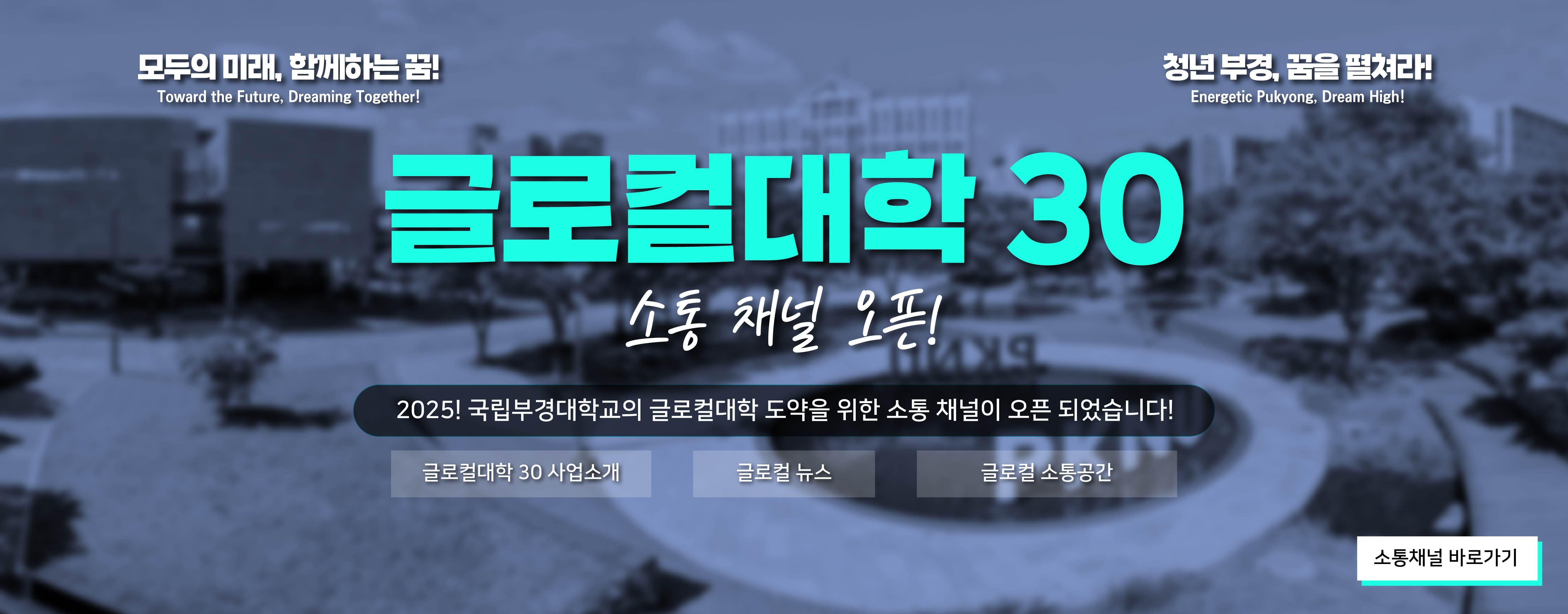
-
2025학년도 하계 계절수업 개설 희망강좌 수요조사 안내
2025-03-28 -
국립부경대학교 「헌혈 행사」안내 및 참여 요청
2025-03-27 -
[★★★해외 파견 단기어학연수] 2025 하계 글로벌어학실습 참가자 모집
2025-03-26 -
[학생상담센터] 신입생 및 재학생 실태조사 참여 이벤트!
2025-03-25 -
#### [HD현대이엔티] 채용상담회 안내(4/1(화) 11:00~16:00, 동원장보고관 109호(취업설명회실)) ####
2025-03-18 -
[2025년] 국립대학육성사업 제5기 학생모니터링단(부경나르미) 모집 안내
2025-03-28 -
제3차 황당규제 공모전 알림
2025-03-28
-
[대학일자리플러스센터] 「취업골든타임 프로그램 - 자소서·면접UP」 참여자 모집(졸업생 특화)
2025-03-26 -
[교수학습지원팀] 25-1 선배 멘토링 프로그램 신청 안내
2025-03-21 -
4월 심리검사 일정안내(학생상담센터)
2025-03-18 -
비교과 통합 플랫폼 '웨일비' 홈페이지 이전 안내
2025-03-28 -
♥비교과 서포터즈 (비즈 bee-s)♥ 진길이의 성장일기 <10화>
2025-03-28 -
[대학일자리플러스센터] 자소서 작성 기초반 특강 안내
2025-03-25 -
[SW중심대학사업] 2025 창업 전문가 초청 특강 참여자 모집(~3/25)
2025-03-24
-
★2025년 대학생 청소년 교육지원 사업 멘토 모집 공고(3.28.(금) ~ 4.7.(월))★
2025-03-27 -
2025년 1학기 한국장학재단 학자금 대출 안내
2025-01-03 -
2025학년도 동원프론티어장학금 장학생 최종 합격자 공고
2025-03-28 -
2025년도 기아드림(Dream) 장학금 지원사업 안내<~ 4. 17.(목) 16:00까지>
2025-03-27 -
2025학년도 대통령과학장학금 신규장학생 학생 신청 안내
2025-03-26 -
★2025년 우수학생 국가장학금(인문100년,예술체육비전) 학생 사전 신청 안내(2025.3.26.~4.16. 18시까지)★
2025-03-26 -
2025년도 (재)인천인재평생교육진흥원 상반기 장학생 선발 안내<~ 4.20.(일)>
2025-03-25
-
[채용공고] 학부대학 기간제 연구·행정요원 채용 공고
2025-03-12 -
[2025년도 1학기 산업대학원 임상영양학과 겸임교원 채용공고
2025-03-27 -
[채용공고] 자연과학대학 간호학과 실습조교 채용공고
2025-03-19 -
[채용공고] 정보융학대학 해양스포츠전공 공무원 조교 채용 공고
2025-03-14 -
[채용공고] 교육부 청년인턴 채용공고
2025-03-14 -
국립부경대학교 이차전지특성화대학지원사업단 사무원(기간제계약직원) 추가 채용 서류합격자 공고
2025-03-10 -
[채용공고] 공과대학 지속가능공학부 토목공학전공 조교 채용
2025-03-07
PUKYONG NATIONAL UNIVERSITY
부경나우
PUKYONG NATIONAL UNIVERSITY
부경나우
 여기서 부산 불꽃축제가 보인다고?
여기서 부산 불꽃축제가 보인다고?
 자유전공학부 새내기들 대학 적응 돕는다 - 국립부경대, 12일 ‘부경 꿈 길라잡이 캠프’ 개최
자유전공학부 새내기들 대학 적응 돕는다 - 국립부경대, 12일 ‘부경 꿈 길라잡이 캠프’ 개최
 국립부경대학교 드론 풍경 홍보동영상
국립부경대학교 드론 풍경 홍보동영상
 국립부경대, ‘자유전공학부’ 첫 신입생 맞았다
국립부경대, ‘자유전공학부’ 첫 신입생 맞았다
 2025 국립부경대 Move;on 새내기 문화제 - 17일부터 4일간 … 단과대학별 OT 등 진행
2025 국립부경대 Move;on 새내기 문화제 - 17일부터 4일간 … 단과대학별 OT 등 진행
 여기서 부산 불꽃축제가 보인다고?
여기서 부산 불꽃축제가 보인다고?
 자유전공학부 새내기들 대학 적응 돕는다 - 국립부경대, 12일 ‘부경 꿈 길라잡이 캠프’ 개최
자유전공학부 새내기들 대학 적응 돕는다 - 국립부경대, 12일 ‘부경 꿈 길라잡이 캠프’ 개최
 국립부경대학교 드론 풍경 홍보동영상
국립부경대학교 드론 풍경 홍보동영상
 국립부경대, ‘자유전공학부’ 첫 신입생 맞았다
국립부경대, ‘자유전공학부’ 첫 신입생 맞았다
 2025 국립부경대 Move;on 새내기 문화제 - 17일부터 4일간 … 단과대학별 OT 등 진행
2025 국립부경대 Move;on 새내기 문화제 - 17일부터 4일간 … 단과대학별 OT 등 진행
 여기서 부산 불꽃축제가 보인다고?
여기서 부산 불꽃축제가 보인다고?
 자유전공학부 새내기들 대학 적응 돕는다 - 국립부경대, 12일 ‘부경 꿈 길라잡이 캠프’ 개최
자유전공학부 새내기들 대학 적응 돕는다 - 국립부경대, 12일 ‘부경 꿈 길라잡이 캠프’ 개최

















